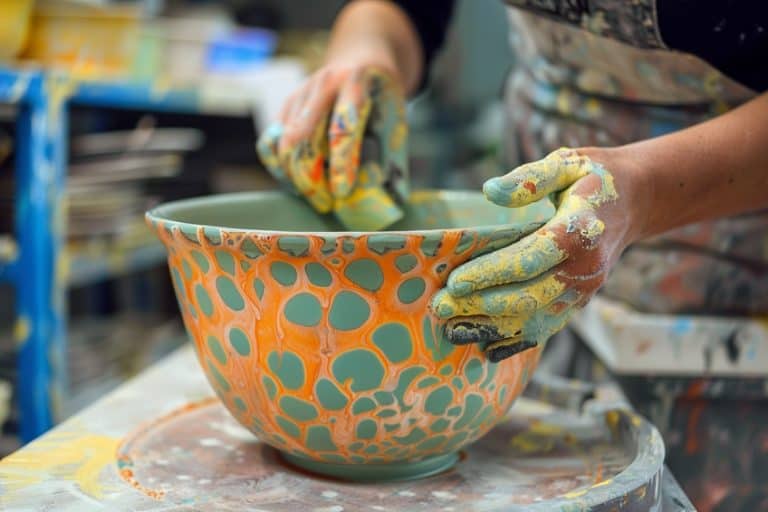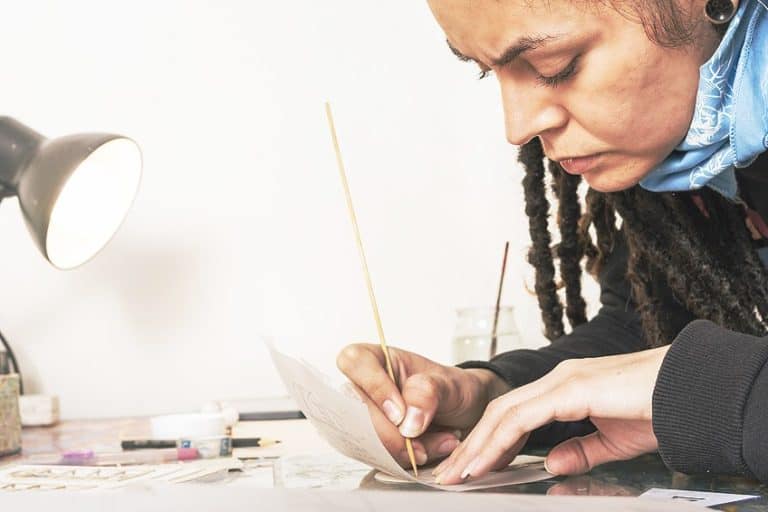Batik Art – What Is the Art of Batik?
Most cultures have some form of traditional art that becomes well-known, and eventually, it may even represent that culture or country. However, there are very few of these traditional art forms that show flexibility and resourcefulness as much as the Indonesian traditional art form of batik. Batik art is categorized as a craft, as well as an art form, that has spread to the Western world and has become very popular amongst contemporary artists. In this article, we will be exploring batik art in greater detail, and showing you how you can also be part of this unique art form!
Table of Contents
What Is Batik Art?
The term batik comes from the Javanese word “ambatik”, which means “cloth with small dots. The art of batik is a textile dyeing technique, whereby wax and dye are mixed to create a pattern on various types of fabric, such as cotton, silk, linen, rayon, and hemp. However, the batik art techniques can also be applied to leather, wood, paper, and even ceramics. When creating batik art, hot melted wax is taken and applied to a pattern on the fabric. The fabric is then taken and dyed the desired color and then placed in boiling water to remove the wax. Once the wax has been removed, the area remains the same as the original color of the fabric, while the rest of the fabric is the color that was used for dyeing.

This process can be repeated as many times as desired, using different colors and creating elaborate unique designs and patterns on the fabric. This process is referred to as dye resistance, where the wax serves as a form of shield to protect those areas from the dye, leaving you with the designs and patterns you want to create.
Brief History of Batik Art
The evidence of batik prints has been part of Indonesian tradition ever since the fifth century. It has been part of their entire life, depicting births, marriages, and deaths, to this day. Initially, it was only worn by the royal family, assigning a batik parang, which is a special motif symbolizing power. So, each member of the lineage from kings or rulers to noblemen wore batik. Examples of batik garments have also been traced back to Egyptian and Indian regions. Similarly, there have been discoveries of batik found by archeologists in Pharaoh’s tomb, of cloth, produced by a wax process, dating back to 5000 BC. However, the oldest batik textile cloth, dating back to the fifth century, was found in Toraja Regency on Sulawesi Island, an Indonesian island located east of Borneo.
In China, during the Han Dynasty (220 to 206 BC), and the Sui Dynasty (581 to 618 BC), the batik art technique was used as a means of livelihood.
Even today, some of the minority Chinese people, such as the Bouyei, Miao, and the Gejia, use this technique to produce their fabric. During the Nara Period (710 to 784 CE) and the Heian Period (794 to 1185 AD), the Japanese used this technique extensively. During the 16th and 19th centuries, batik art experienced a great deal of change, especially concerning its motifs and philosophies. Some of the concepts had relevance to Buddhists or Hindus, while others were adapted for Islam, but kept the traditional motif intact, to keep Islamic hierarchies, values, and social customs prevalent during that era.

During the Dutch VOC era (Vereenigde Oostindische Compagnie), closer to the 20th century, the Javanese batik was used by merchants for trade, helping spread the wax-resist dyeing technique to many places around the world. In September 2009, UNESCO (United Nations Educational, Scientific and Cultural Organization), assigned batik as an intangible cultural heritage, motivating the safeguarding of this cultural textile heritage. Indonesians are, therefore, encouraged to wear batik clothing that can connect them to their natural heritage.
So, every Friday, the locals and tourists can be seen wearing beautiful batik-designed clothing with pride, and in many parts of the world, these batik garments are worn on special occasions.
Traditional Materials and Tools Required
For those people using the art of batik to produce their patterns and designs, various tools and materials are necessary, and we will be sharing these with you. But for the beginner who just wants to create designs and patterns as a hobby, not many tools and materials are required, which you will see as you read further.
Types of Fabric Used in Batik
Various types of fabric can be used in batik, which includes silk, poplin, linen, muslin, hemp, viscose, rayon, and cotton. However, cotton is the preferred fabric to use in batik as it has the right weight, has a smooth surface, the weave is not too close, is absorbent, can soak up lots of dye, and can withstand a lot of heat.
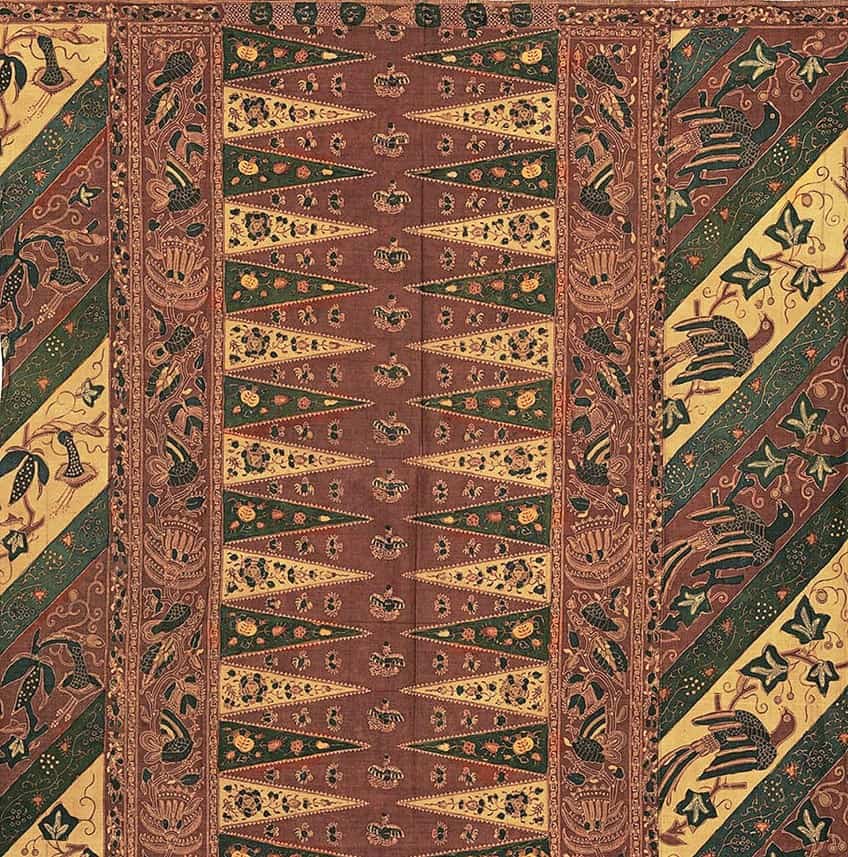
Types of Wax Used in Batik
Using the right type of wax for your batik designs is essential, as the incorrect wax will not give you the desired amount of dye resistance. There are four types of wax that you can use for your batik patterns, which will give you good results.
- Traditional batik wax: This is the best choice as it contains beeswax, paraffin wax, and plant resins that perform as dye-resistant agents, and melts at very low heat. However, it is difficult to obtain and is rather expensive.
- Beeswax: A natural wax, ideal for creating those delicate lines on your more detailed patterns, and very easy to remove from the fabric. However, it can be rather difficult to work.
- Paraffin wax: A synthetic wax produced from petroleum, which is easy to come by, is cheaper than beeswax, and covers large areas. However, it is difficult to work with as it does not melt evenly and is also very difficult to remove from your fabric once the pattern is complete.
- Soy wax: Made from soybean, it is biodegradable and non-toxic. It is ideal for covering large areas and is easily removed from the fabric once the designs are complete.
- Candle wax: You can use ordinary candle wax, as it is very cheap, easily available, and also melts evenly.
Types of Dyes Used in Batik
The process of dyeing is to add color and create patterns on your fabric. The colorants used by batik artists are obtained from berries, nuts, flowers, other plants and vegetables, animals, and mineral sources, and are called natural dyes. Below are examples of the best dyes for batik designs and patterns.
- Naphthol dyes: These are cold water dyes and are suitable for batik because they require the heat of the wax to process the dye, but they do contain some dangerous chemicals, making them unsuitable for home use.
- Vat dyes: Natural and insoluble in water, these dyes can be applied directly from the container, and their color fastness is excellent.
- Remasol batik dyes: A water-soluble powder dye that works well on cellulose materials like cotton and linen but is not suitable for use on nylon or any other synthetic materials.
- Procyon MX dyes: These are specially formulated for use on cellulose fibers like cotton, linen, and viscose. When applied the dye reacts chemically with the fibers, forming a permanent bond with your fabric.
- Tie dyes: Tie dyes are permanent and non-toxic and are supplied in a kit form. They work well on most types of fabric.
Tools Used in Batik-Making Process
There are a few tools that are recommended when you start with your batik art designs and patterns. If you are just a beginner and working from home, and you do not have any of these tools, you can use any type of tool you have to make it work for you.
- Canting: A tool that looks like a pen, its main function is to paint motifs onto the fabric.
- Small stove and frying pan: An essential tool where the wax is melted.
- Buckets or tubs: When doing your batik art, you need a container, like a bucket or a tub, which holds the dye or color you want to use on your fabric.
- Pendulums: A pendulum is a weight that you can use to hold your batik fabric stiff when you are working with it, usually made from iron or wood.
- Gawangan: A wooden or bamboo tool that serves as a support for your fabric during the batik-making process. It is used when you are creating a piece of large batik fabric.
Styles of Batik
There are thousands of different batik styles and designs, some designs have been traditionally associated with specific religious ceremonies or traditional feasts. Some even believe that certain batik styles have some form of mystical powers that could ward off evil fortune or bring good luck.
Traditional Batik
Some batik art styles were reserved especially for brides and bridegrooms, while other styles were reserved for the Sultan and his family. The rank the person held would determine the pattern or style of batik that they were allowed to wear. There are two categories of batik art styles; geometric motifs, which are the earlier designs, and free-form styles, which are naturally formed patterns or imitations of woven textures. Certain designs or styles are predominant in certain areas, Central Javanese styles are inspired by traditional colors and patterns, while on the north coast of Java, you will find styles inspired by the Chinese culture that shows brighter colors with intricate flower designs.
Below are more traditional designs.
Kawung
This is a very old design or style from the 13th century and consists of intersecting circles that can be seen in many of the Javanese temples, carved into the walls. Originally it was a pattern reserved for royalty, where the circles were embellished with small crosses or other types of ornaments.
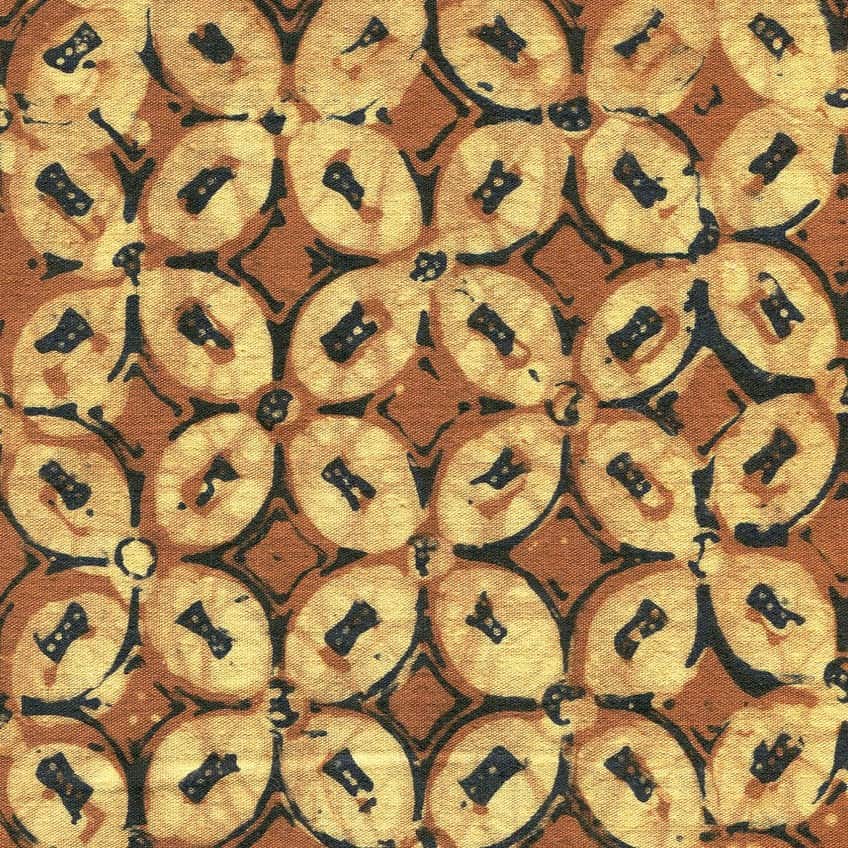
Ceplok
This is a style that consists of a series of geometric designs such as squares, circles, stars, rhombuses, and many more. It can represent abstract forms of flowers, seeds, and even animals, and the colors are intense, creating an illusion of depth and having an effect like the designs on a Turkish rug.
Parang
This is a style or design that is exclusive to the royal courts of Central Java and has several meanings like a rugged rock, a knife pattern, or a broken blade. The style consists of thick slanting lines running in parallel diagonal rows, with alternating thinner lines in a darker color. The darker lines can also contain other elements shaped like lozenges called “mlinion”. There are dozens of variations of this striped pattern, the most famous being “Parang Rusak”, which consists of rows of folded parang. This motif does not only appear in batik designs but is also found in woodcarving and ornamentation of musical instruments.

Regional Variations in Batik Styles
Batik art plays an important part in Indonesian culture and contains symbols of their culture, which is deeply embedded in their everyday lives. Each area or region in Indonesia has its own unique traditional batik pattern or style, and these batik styles are different from other batik styles that are found in other areas or regions.
Below, you can find different types of batik motifs found in Indonesia.
Batik Pesisiran
In the coastal areas of Java like Cirebon, they use brighter colors due to their role as a port. They have also been influenced by the Chinese and often use the cloud pattern, depicting the phoenix bird and dragon. They also use red and yellow, representing prosperity and luck, and in modern times. The colored patterns also incorporate green, brown, and blue, representing masculinity.

Batik Pedalaman
Inland areas or regions of Java support some of the oldest types or styles of batik, like Surakarta and Yogyakarta, where the batik designs are reserved for royalty and the patterns are subject to strict rules and codes.
Colors for these batik motifs were limited to indigo, black, sogan (brown-toned), or brown-yellow.
Batik Banten
This batik design is distinctive from all the other batik designs in Indonesia, using pastel shades and bright colors. This batik style has been influenced by the Chinese who immigrated to Indonesia and has also been influenced by Islam, with Arabic touches.

Batik Kudus
This batik style has been influenced by Pekalonan, Solo, and Yogyakarta patterns, using sogan colors that are a little more colorful. Depending on what area or region It comes from, it may depict different images, like spears, butterflies, flowers, or geometric patterns.
It can be distinguished by its intricate details in the main pattern.
Contemporary Batik
Contemporary batik is a lot different from traditional batik art styles, where artists and designers are interpreting traditional techniques in exciting and new ways. They use a variety of techniques when applying the wax and the dyes, like spraying, cracking, etching, and marbling. They also use different tools, like wooden stamps and stencils. Let us take a look at where batik is used in the modern world.

Batik in Fashion and Design
Designers of clothing and accessories are now creating batik fabrics that have an exotic touch. Décor designers have also created cushion covers and curtains with batik patterns and colors, and there is even batik kitchenware.
The popularity of batik in these fields has made the designs accessible to a lot more people.
Batik in the Digital World
Digital technology is playing a huge role in reviving batik styles and designs. Using digital printing, you can now produce intricate batik art designs on a very large scale and at a much lower cost. Also, e-commerce makes it a lot easier for customers to buy batik products, opening the market to global audiences.

Other Batik Styles
There are many more different batik pattern style variations, which all have their distinct style and design, such as Batik Jepara, Batik Malang, Batik Bali, Batik Aceh, Batik Kediri, and Batik Tulungagung. There are also Batik styles and designs that are outside of Indonesia.
These all have their distinctive patterns, like Malaysia, India, Sri Lanka, China, and Africa.
Symbolism in Batik
Batik originated on the island of Java and the creation of patterns and lines of the different batik styles are all symbolic. Each style or design is associated with various regions and areas, and the symbolism of those styles is evident in their colorful patterns and motifs. Let us consider some of the symbolism attached to these different styles of batik.

Parang
This is considered one of the oldest batik patterns and is symbolic of intelligence and authority, and means a cliff, slope, or ridge. It consists of parallel rows in s-shapes all arranged diagonally. The wavy pattern depicts waves crashing into a cliff, referring to an unrelenting spirit striving for excellence.
Several variants of this pattern symbolize happiness and wisdom.
Kawung
Kawung symbolizes honesty and purity and was inspired by the cross-section of the sugar palm fruit or kawung. The pattern is made up of four overlapping ellipses or circles, and the four segments symbolize the four directions of the compass, while the center symbolizes the divine elements of the universe.

Truntum
This symbolizes everlasting and unconditional love, and it resembles twinkling stars in the night sky or tiny jasmine flowers. It means something that can grow like a flower or give guidance like a star and is therefore worn by the bride’s and groom’s parents at their wedding.
Finally, they hope to give guidance to the newlyweds in their new life together.
Other Batik Symbolism
There are many more batik styles and patterns that are symbolic for the people who create and wear them, where the motifs contain certain meanings and are intended to be worn at different occasions or ceremonies. See below for some of them.
- Gringsing: The pattern is used to ward off misfortune and evil and is tied to a ship’s mast to ensure an abundant catch, or a baby’s crib to ward off any disease.
- Semen: This pattern represents a vine, rosettes, and tendrils that are spiraling around an object, symbolizing growth on land, water, and air, and means authority, leadership, and happiness.
- Alas-alasan: This pattern depicts a forest that is full of animals and plants and symbolizes fertility. It is reserved for special occasions like royal weddings, court ceremonies, and palace dances.
- Sawat (Lar): This pattern means wings and depicts the wings of a half-man, half-bird creature in Hindu mythology. It symbolizes the king’s duty and power and is associated with success.
- Sekar jagad: This pattern means the map of the world or the flowers of the universe, where the pattern is a collection of several batik patterns and is represented by flowers and islands.
- Mega mendung: This pattern is a repetitive series of clouds and symbolizes the seven layers of heaven, seven layers of earth, and seven layers of days in a week, and is closely linked with the court of Cirebon.

Color Symbolism Used in Batik
Just as the batik patterns symbolize different emotions and feelings with their design and style, so do the colors used by batik artists in the batik designs have a symbolic meaning. The thing that stands out the most in batik patterns is vibrant colors, and the most popular or common colors used are black, brown, red, and green.
- Black: This is symbolic of worldliness, power, and authority.
- Brown: This is symbolic of humility, modesty, stability, and closeness to nature.
- Blue: This is symbolic of trustworthiness, tranquillity, and calmness.
- Green: This is symbolic of calmness, harmony, and soothing.
- Red: This is symbolic of anger, energy, passion, enthusiasm, and confidence.
- White: This is symbolic of purity, freshness, cleanness, and simplicity.
- Yellow: This is symbolic of happiness, hope, fun, optimism, and enlightenment.
Other colors like white, yellow, and orange-brown are also used in some of the patterns. Let us now consider the symbolism of each of these colors.
Famous Designers Who Incorporated Batik in Their Designs
The art of batik originated in Indonesia but soon spread to other regions throughout the world. Many designers have incorporated batik motifs and designs or styles in their work. Let us now consider some of these famous designers from various regions.
- Indonesia: Some famous Indonesian designers include Oscar Lawalata, Denny Wirawan, Edward Hutabarat, Chossy Latu, Ramli, and Ghea Panggabean, amongst others.
- Sri Lanka: A few famous Sri Lankan designers using batik include Ajantha Ranasinghe, Chandraguptha, Thenuwara, and Senaka Senanayake.
- Africa: Famous African designers using batik include Christie Brown, Maxhosa Afrika, Loza Maleombho, Maki Oh, and Kenneth Ize.
- Malaysia: Some famous Malaysian designers include Tom Abang Saufi, Emilia Tan, and Adila Long.
- India: A few famous Indian designers include Anita Dongre, Ranjana Khan, Bibhu Mohapatra, Tarun Tahiliani, and Ritu Kumar.
- China: Some famous Chinese designers include Lee Kian Seng, Seah Kim Joo, Chew Kiat Lim, Lee Long Looi, and Ho Hee Khim, amongst others.

The Batik-Making Process
Batik art is very special due to its history and cultural connection, and it is impossible to separate it from the cultural heritage of Java and Indonesia as a whole. Even as the different techniques are shared around the world, batik art will always remain a practice of spiritual and cultural significance, just as much as the designs themselves.
Let us now consider how to batik.
Materials and Tools Needed
For the art of batik-making, certain tools and materials are required, and most of them will be able to be found in your local art supply or hardware stores. Below is a comprehensive list of all that you need to start your batik-making process.
- Fabric
- A design
- Paraffin and beeswax
- Wax pot
- Dye
- Soda ash or salt
- Tjanting or chanting tools
- Scissors
- Clear tape
- Small paintbrush
- HB pencil
- Rubber gloves
- Pot of boiling water
- Small stove
- Newspaper
- Iron
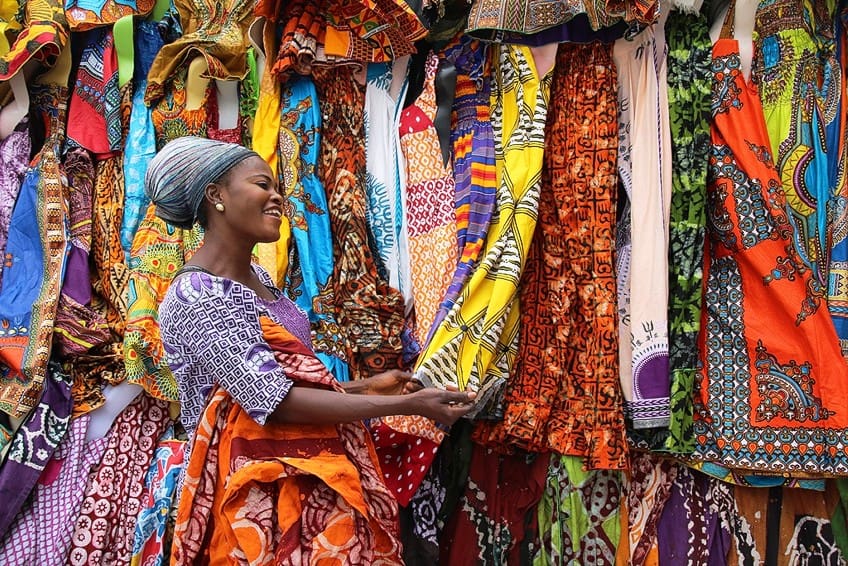
Prepare the Fabric
Pre-wash your piece of fabric with a gentle fabric detergent and hang it up to dry. Next, iron the fabric and cut the fabric to the desired size. Lay the fabric down completely flat on the surface you are going to work from and ensure it will not move by using some tape to hold it in place.
Take your transfer design and lay it down on the fabric and begin to trace your design onto the fabric using your pencil.
Wax the Fabric
Take your wax and put it into the pot and melt it over the stove. Next, take your tjanting tool, which is a special needle or pen-shaped tool, and dip it into the melted wax, filling the basin. Take the “pen” with the wax and use it on the fabric, only over the area where you do not want any dye to show. Take a small paintbrush to spread the wax over the whole area.

Dye the Fabric
Choose the desired colorants used by batik artists and prepare a dye bath following the instructions on the packaging. If necessary, add some soda ash or salt to the dye mixture to balance the pH level. Using your rubber gloves dip the wax-coated fabric into the dye bath and let it soak for about 30 minutes. Let it soak for less or more time, depending on how dark you want it to be. Ensure your fabric is completely submerged, as any contact with the air will cause the color to set. Use the spoon to stir every 10 to 20 minutes.
Next, remove the fabric from the bath and hang it out to dry, squeezing out as much dye as you can.
Boil Out the Wax
It is now time to remove all the wax from the fabric. Take the fabric and place it between two pieces of newspaper, and iron it at the temperature recommended for that fabric. When you have removed as much wax as possible, you will then need to boil out the remaining wax by placing water into a bowl and bringing it to a boil on the stove.
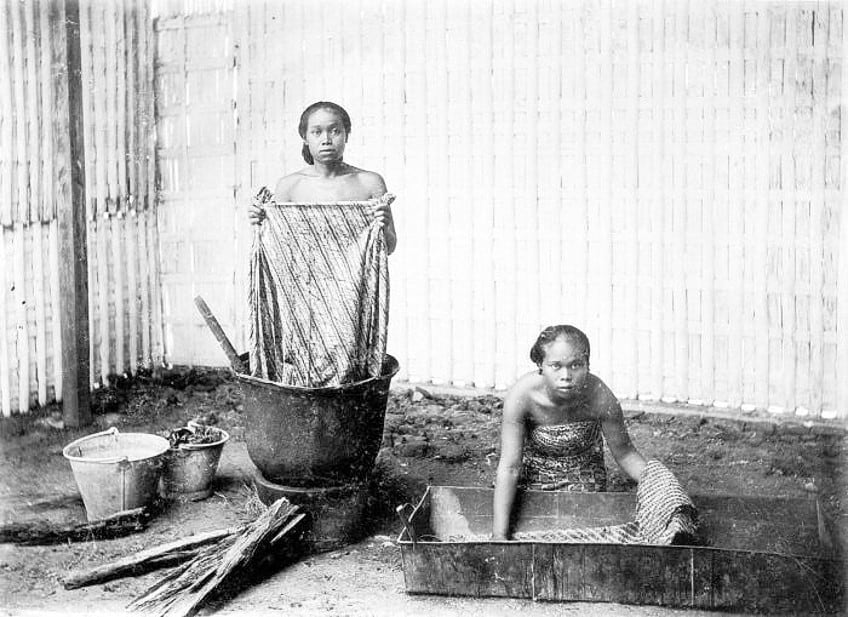
Place the fabric into the boiling water for about three minutes, then remove the fabric from the boiling water and place it immediately into a bucket of cold water. This will solidify the remaining wax, and you can observe it floating on the water. Repeat this process, and your fabric is complete.
Batik art is one of the most subtle and expressive art forms of resist methods that offer a wide range of techniques, allowing you to explore these various processes in exciting ways. The batik processes offer surprise elements that will fascinate you, so delve in and enjoy your batik art experience!
Frequently Asked Questions
What Is Batik Art?
Batik art is the art of decorating a piece of fabric by using wax and dye. The technique has been practiced for centuries all over the world in China, Japan, South America, Africa, Malaysia, Sri Lanka, and India. The technique can also be applied to other surfaces like paper, wood, leather, and even on ceramics.
How Is Batik Made?
Wondering how to make batik? Select a piece of fabric, preferably cotton, wash it, and then draw your design onto the fabric once it dries. Apply the wax to the areas you do not want dye on, then dye your fabric. Place the fabric into a bath of hot water to remove the wax, and the batik process is complete.
What Is the Significance of Batik as a Cultural Heritage?
Batik art is rich in Indonesia’s culture and is used in various celebrations, rituals, and traditions. Many of its motifs carry symbolic meanings that are firmly tied to their cultural heritage. Batik art is deeply linked to their cultural identity, with the colors used by batik artists expressing their spiritual beliefs and creativity.
In 2005, Charlene completed her Wellness Diplomas in Therapeutic Aromatherapy and Reflexology from the International School of Reflexology and Meridian Therapy. She worked for a company offering corporate wellness programs for a couple of years, before opening up her own therapy practice. It was in 2015 that a friend, who was a digital marketer, asked her to join her company as a content creator, and this is where she found her excitement for writing.
Since joining the content writing world, she has gained a lot of experience over the years writing on a diverse selection of topics, from beauty, health, wellness, travel, and more. Due to various circumstances, she had to close her therapy practice and is now a full-time freelance writer. Being a creative person, she could not pass up the opportunity to contribute to the Art in Context team, where is was in her element, writing about a variety of art and craft topics. Contributing articles for over three years now, her knowledge in this area has grown, and she has gotten to explore her creativity and improve her research and writing skills.
Charlene Lewis has been working for artincontext.org since the relaunch in 2020. She is an experienced writer and mainly focuses on the topics of color theory, painting and drawing.
Learn more about Charlene Lewis and the Art in Context Team.
Cite this Article
Charlene, Lewis, “Batik Art – What Is the Art of Batik?.” Art in Context. July 11, 2023. URL: https://artincontext.org/batik-art/
Lewis, C. (2023, 11 July). Batik Art – What Is the Art of Batik?. Art in Context. https://artincontext.org/batik-art/
Lewis, Charlene. “Batik Art – What Is the Art of Batik?.” Art in Context, July 11, 2023. https://artincontext.org/batik-art/.






